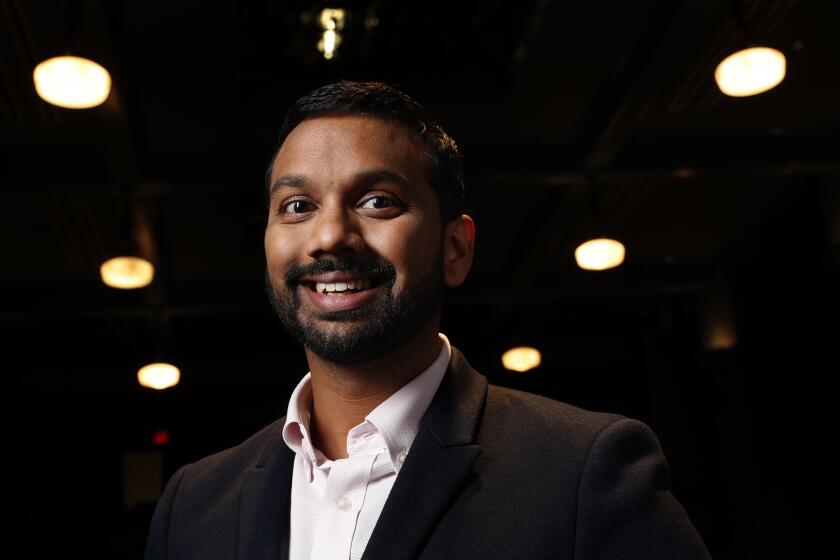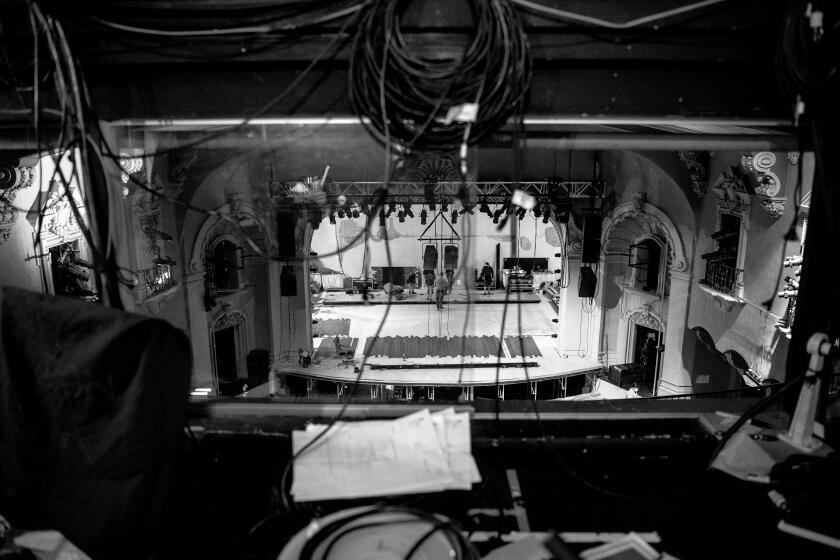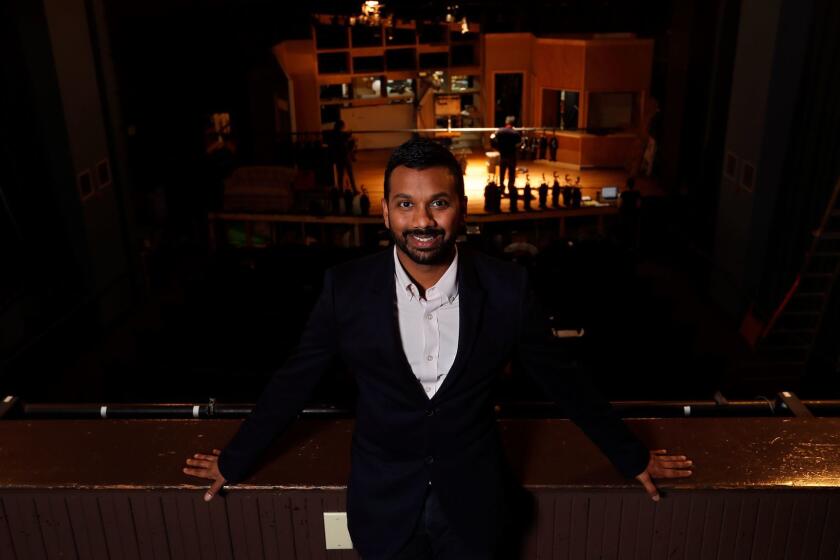Center Theatre Group is at an inflection point. New artistic director Snehal Desai aims to ‘turn the ship’
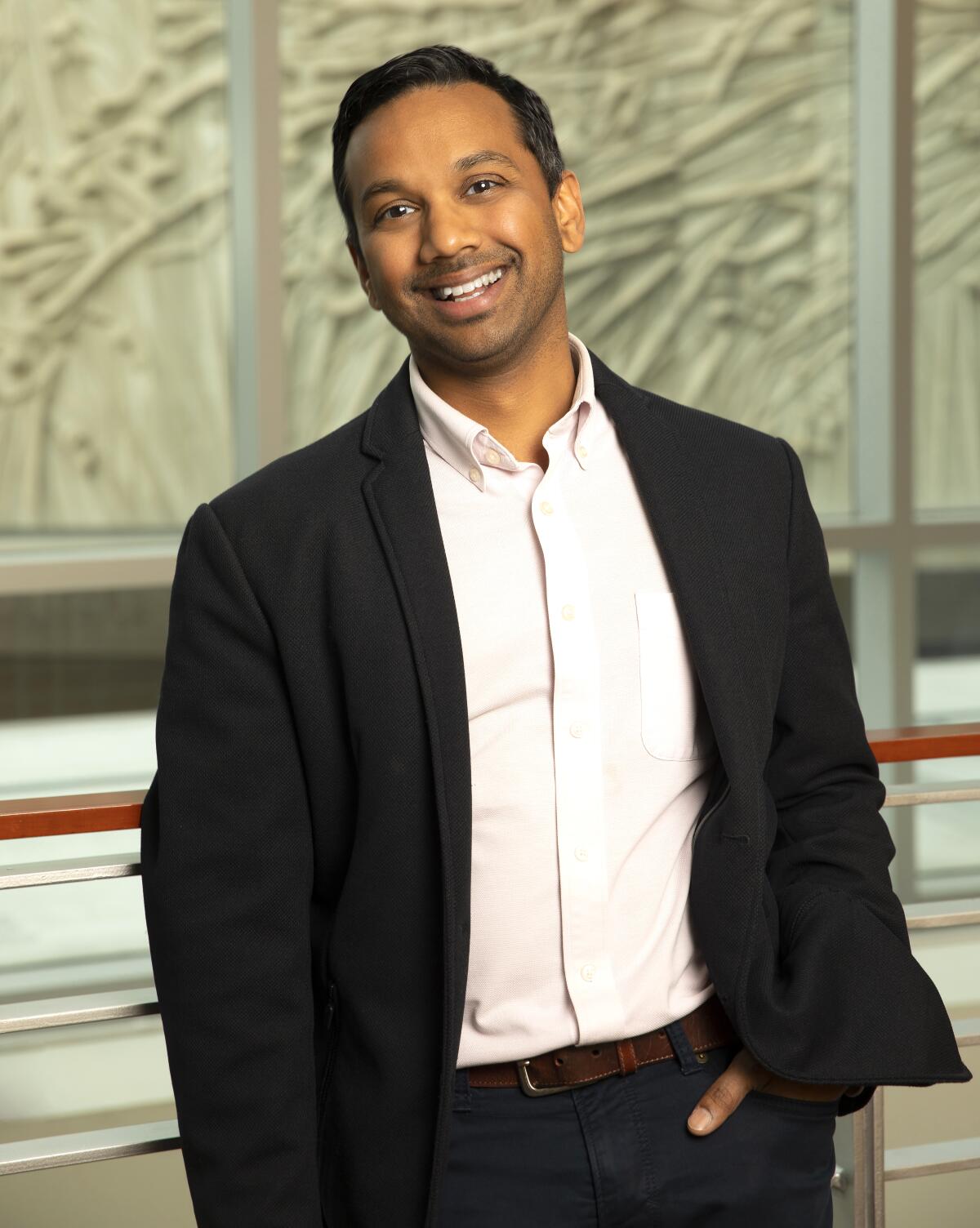
Shortly after Snehal Desai was approved by Center Theatre Group’s board of directors on Wednesday as the company’s new artistic director, he answered questions on Zoom about how he was going to steward Los Angeles’ flagship theater organization into the future.
Desai, who has served as producing artistic director of East West Players since 2016, doesn’t have the big-league directing or Broadway producing credits that might have been considered a prerequisite in an earlier era of CTG’s history. But the American theater, still reeling from the pandemic disruption and the cultural reckonings that followed, could do with bolder vision.
In selecting a Los Angeles-based artistic leader, CTG seems to have received the message that local knowledge of a sprawling, culturally complex city is necessary to rebuilding the communal connection that had been fraying for years. And in deciding on an artistic director of color, who has been a leading advocate for issues of equity, diversity and inclusion in the American theater, the company appears to be putting its money where its mouth is.
Center Theatre Group has named Snehal Desai as its artistic director, making the East West Players leader the first person of color to helm the organization.
Congratulations on your appointment. What was your initial reaction to the news?
It was really overwhelming. It’s been over nine months, so it has been a journey being a candidate. And it’s still one of those things where it doesn’t feel real. I think it will feel real on Saturday at the Center Theatre Group Gala, when I’m up there on the stage of the Taper for the first time to the community.
I’m happy CTG chose an L.A. person, but also a little surprised given the company’s history.
I think the hope was that it would be somebody from L.A. For me, personally, I was hoping it would be an artist and a person of color. Obviously, we know how these searches can go. But for L.A. theater, we’re just at an interesting moment, coming back from the pandemic, the challenges that we’re finding in terms of reconnecting and building our audiences again.
So you’ll be an artist as well as an administrator?
I want to be an artist at the institution that I’m leading. And I think it’s important in two ways. One, it’s great just to be in touch with my craft. Two, knowing what it’s like to be an artist at the institution is how I can make it better for artists. That’s how I made East West Players better for artists. And it’s the same thing I want for CTG when the time is right. I also feel as an artist I have built up a following. Three of the shows I directed at EWP are now the highest-grossing shows and the most attended in our history. And so I hope that can continue at CTG.
You haven’t yet directed at CTG, but it’s fairly standard for an artistic director to direct a certain number of shows a season.
We haven’t put it in specifically that I’m going to direct two shows a season. We’ll see where we land with the programming. As a producer, I’m looking at matching the right director to the right playwright.
After nearly two years of pandemic closures, live theater has returned. But attendance is down, operational costs are soaring, and leaders are worried.
What do you think distinguished you from the other candidates?
It’s a great question. And maybe one for the committee. What drives me is building community. I think great work has something to say about the world we live in. Social justice and work of the highest artistic caliber are not mutually exclusive. Oftentimes, when you’re coming from a theater of color, or a culturally specific institution, people do look at you as though you have an agenda or a mission. For me, craft and the quality of the work and the artist are really important.
The other thing I would point to are the partnerships, the co-productions that EWP has had during my tenure not only with CTG but with Pasadena Playhouse, the Fountain Theatre and Rogue Artists Ensemble. The future of theater lies in co-productions and partnerships, where we’re building audiences and sharing community. I want CTG to be a place where we are able to work with all of the various theaters here in L.A., as well as to partner nationally on works that can go from here to D.C. to New York to London.
I’ve been speaking with people who were either in the running for the artistic director job or who were brought in to provide feedback to CTG. And the consensus has been that this is an impossible job. Leading a theater of this size through all the current economic and cultural changes is daunting. You obviously don’t think it’s impossible or you wouldn’t be here. What gives you confidence that you can set this institution on a sustainable future path?
No, they are impossible jobs! In some ways I’ve gone through this transition before. When I took over at East West Players, I was following a predecessor who had been there for 20-plus years. When I came in at EWP, we had maybe two months of operating costs in the bank, no lines of credit, massive amount of debt. But I was able to turn the ship around.
I would say CTG is in a similar hard moment right now. The times are different and so is the scale, but I’ve been through it. When we were in the middle of COVID, people were commenting on how calm I was. Nothing was as hard as my first six months at EWP. I was a brand-new artistic director, relatively new to L.A. And now those things are very different. I’ve been here for a decade. I feel like I have a lot of colleagues in the field and we’re talking constantly. And I like a good challenge.
What do you consider the most urgent challenge facing CTG?
I would say reconnecting with the community and producing work that feels relevant and responsive to the moment we’re in. Doing something like “Twilight: Los Angeles, 1992” at the Taper felt really important and urgent to me. When I first came to EWP, we were in a place where we needed money but we also needed butts in seats. At that time, I was like, “Well, both are important. How do I prioritize?” Ultimately, what I’ve learned is you have to get people in the theater first. You have to show them the value of what we’re doing.
People are hungry for a space where they can heal and laugh. Where also we can let our guard down and trust each other, which is really hard to do. I’m going to lean on the CTG board and donor community to give me a little bit of runway so I can start programming and creating work that can bring folks back.
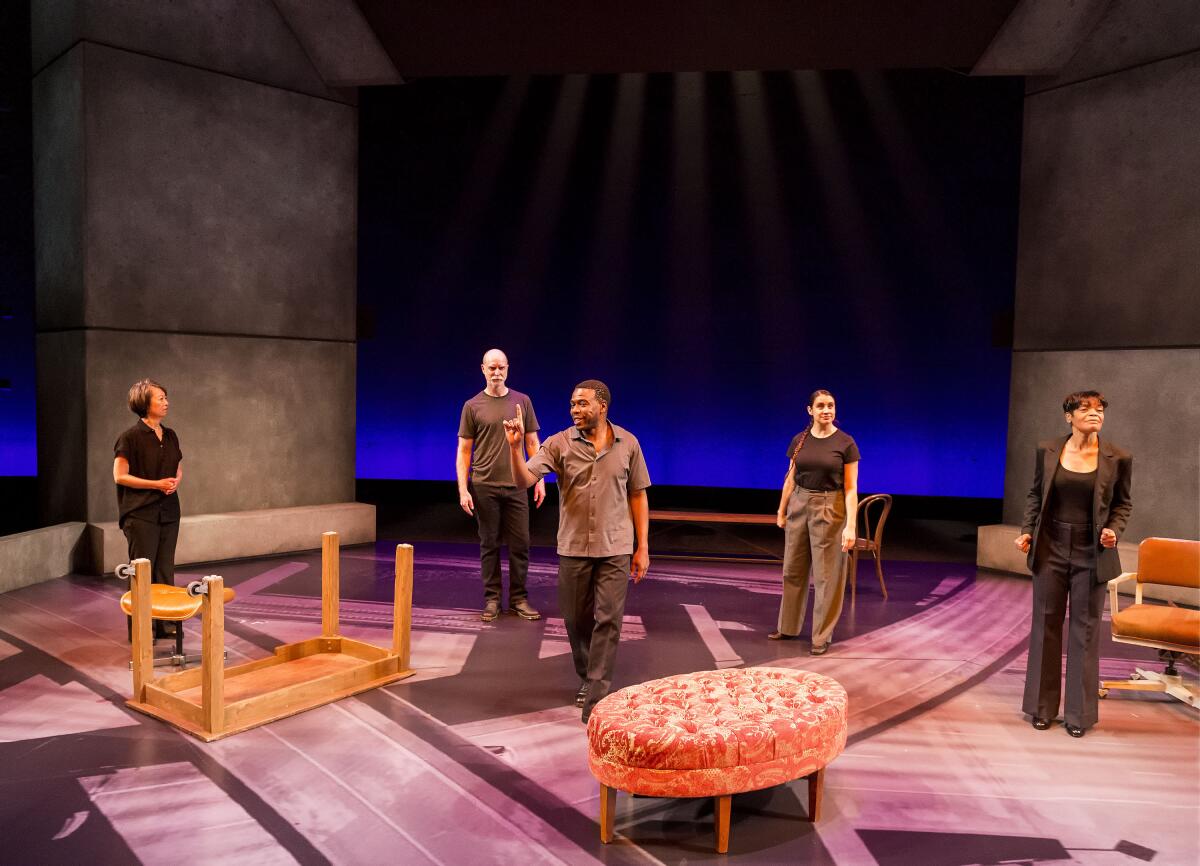
How do you think CTG has answered the call for greater reckoning on issues of equity, diversity and inclusion? And what is your vision for moving the company forward?
I want what is on CTG’s stages to reflect the city of Los Angeles. That’s how we’re going to build the audience that we want and gain the trust with the community.
How do you balance the need to maintain existing audiences with the imperative of building new ones?
Not everything is going to be for everyone. And I think you dilute the work by trying to make every piece reach everyone. That being said, we have some very large venues and a lot of seats to sell night after night. But you have to look at the whole picture, the overall season. Is there something that hearkens back to the legacy, like a revival of “Twilight” that has a new spin? And then there will be new work.
What I would love to do is to go outside of our theater walls and produce more site-specifically throughout the city. I truly believe to change the flow, to get people to come to the theater, we have to first go meet them where they are and produce work that lifts up what it is to be an Angeleno. We will build the community piece by piece, and it’s a long-term dialogue and conversation. I want people to feel ultimately that there is something for them every year at CTG. More than one piece, but something for everyone.
Given the financial hurdles the company is facing, do you anticipate having to make huge cuts and staff reductions when you arrive?
I have to get in there first and see the lay of the land. What I will say is I believe artistic directors are creatives, and I’m going to have to creatively figure out how to fashion a season within the resources that I have. That’s the first charge. And it may be, as Danny [Feldman] had to do [at Pasadena Playhouse], that we have to go on hiatus or put something on pause or do more nontraditional programs, different lengths of run, until we can get a sense of where we are. And then I can start producing, creating and programming the work that I think will turn the ship.
I also want to have a larger conversation about how much we’re devaluing art right now. We’ve been trying to make theater more accessible by lowering ticket prices. But we’re doing that at a time when the cost of production is more expensive than ever due to COVID, supply chain issues, inflation. We’re also trying to be more equitable to artists, paying them a living wage. So we’re going to have to find a balance.
I don’t want every ticket to be $250. But I want people to understand that an artist spent 10 years of their life working on the piece they’re seeing. I want them to understand the value of that. If you’re willing to pay $200 for a Beyoncé concert, I also want you to be willing to pay $100 for a show at the Taper or the Ahmanson because of what those artists did to bring that work to you. So I feel we have to switch some of those narratives.
You’ve proven to be a talented fundraiser at East West Players.
It is something that I don’t mind and I know it’s going to be a large portion of my job. The thing that I’ve learned is that I had to translate it into storytelling. That’s what fundraising is — it’s storytelling about the value of an organization and the work we’re doing and the artists we’re supporting. Once I found that, things really turned around at EWP.
What are your proudest accomplishments at EWP?
I wanted to make EWP a place that could produce new musicals about people of color by people of color. And we’re finally doing that. I’m also proud of our writers group led by Alice Tuan. I’m so proud of the plays that we premiered, like “Man of God.” And then I’m really proud of the co-productions that allowed us to reach beyond the walls of EWP.
A woman had vanished — and Snehal Desai needed to help find her.
As I understand it, you and Meghan [Pressman, CTG’s managing director and CEO] will both be reporting directly to the board of directors. Have you given thought to how the artistic director-CEO relationship will play out?
Meghan and I went to the Yale School of Drama together. She and I have known each other for almost 20 years. She’s someone I trust. What’s clear is that my charge is the artistic vision of this organization. What we have to both figure out is how to fulfill that mission within the means and resources that we have at this time.
Will your main focus at the start be on the Taper [given that the Ahmanson programming is a more complicated financial calculus involving touring show options]?
I love all three spaces, but the Taper is the space that I’m most passionate about and the one I hold closest to my heart. I was a poli sci and theater major in college. There came a point in my life where I was like, “I want to effect change.” How do you do that? One way is to go to politics and do policy. Or I can do that by putting a face and a name and a story to a cause.
I can effect change through storytelling. And to me the Mark Taper Forum is a community space. It’s a space that is made for big ideas. Those are the plays that have worked so successfully within those walls. But it’s also the space that is the most challenging to program in this day. Because how do you find that play with big ideas and still fill a [nearly] 800-seat theater night after night?
Are you hopeful that the Douglas can be an integral part of CTG’s artistic vision?
That is the space where we can take the most risks and where we can program more nontraditionally, if you will. Part of being an artistic producer is I want the artists to choose the canvas they want to paint on. So my job is to figure out what is the right venue or vessel or scale to tell that story. I liked the Block Party concept, though I don’t know if it was quite working. I don’t know that the shows were having the run time they needed to build audiences.
There’s talk that the Douglas may have to shut down for construction reasons.
To me that’s an opportunity to say, “Well, we don’t have this third space. What can we do instead?” We can explore other venues, produce site-specifically, create works that maybe want to end up at the Douglas.
At East West Players, you’ve made the theater a gathering place. People would arrive early and have a drink or hang out after the show. That doesn’t seem to happen much at CTG events. Everyone looks so harried by traffic and parking.
If after a show what people are doing is getting in their cars and turning on the radio, then we are not doing our job.
How did you create that welcoming environment?
Sometimes it’s the simplest thing. We have pop-up bars now in the EWP courtyard. But it’s also an in-person curtain speech. At openings, we sometimes ask people who’s coming to the theater for the first time. Or the craziest thing, which is to ask them to turn to their neighbor and say hi. All of that helps break down the barriers we come in with. We’re going to try different things, but for me it’s important that these theaters feel like lived-in community spaces. And not sacrosanct spaces where you’re afraid to sneeze.
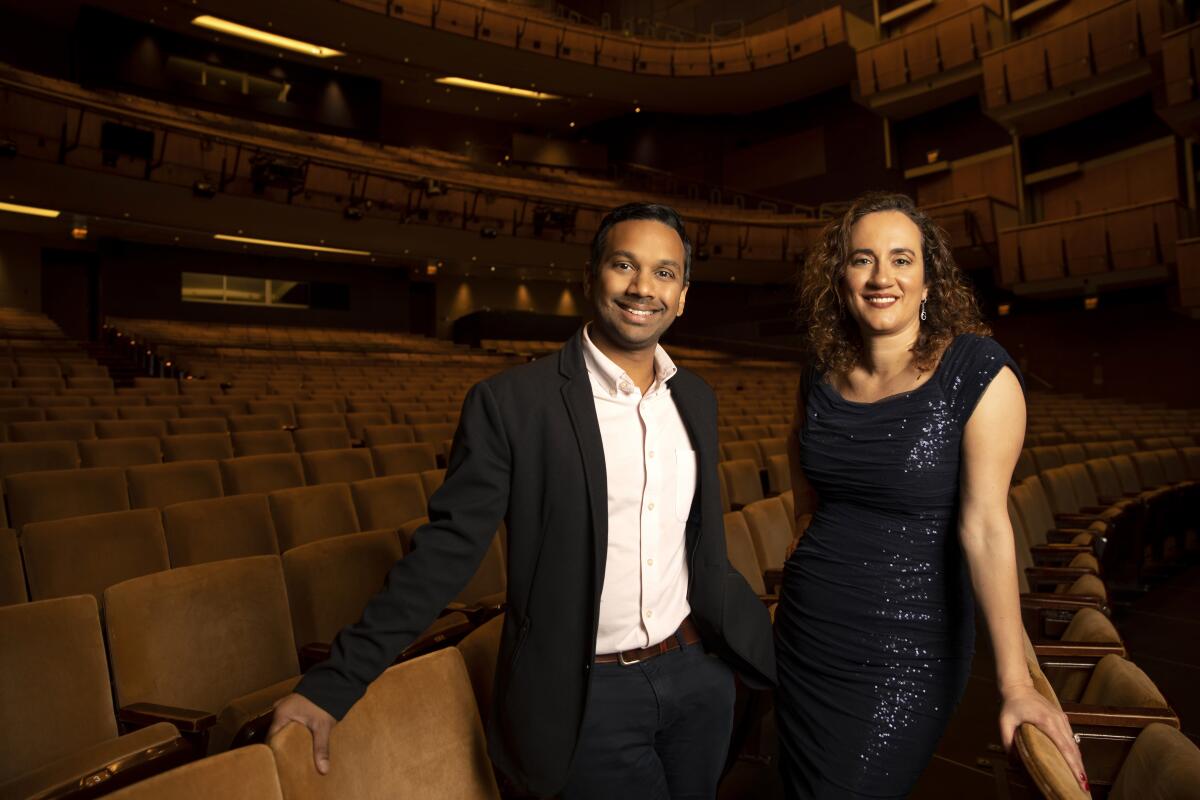
Nonprofit theater boards have been in the news of late — and not for good reasons. Increasingly, they are seen as obstacles to the cultural and institutional changes that many in the theater community think are way overdue. Have you given thought to how you’ll work with the CTG board?
It’s definitely challenging, the 501(c)(3) model. What I admire about board members is that they’re doing it out of the goodness of their hearts. But it’s crazy to be in a field where you’re asking a bunch of business folks, most of whom have never worked at an arts institution, to choose and guide its leadership and help set the vision and strategy. To me, the board should be a microcosm of the community it serves. When you look at the board of East West Players, what I want you to see is a snapshot of the East West Players community. One of the conversations we will have is whether CTG is a microcosm of the community we are seeking to serve. And if not, how can we change that?
During this search process, I’ve been three blocks away. How many of the board members have come to East West Players or engaged with any of the theaters of color in the city? What you’re going to see is a continuity of what I’ve been doing. I’m not suddenly going to become another person when I move to CTG. I’m hoping as they’ve made this decision that they acknowledge that equity, diversity and inclusion is central to my core being as an artist and as a leader and that work is going to continue. And that work is never done. It is baked into the mission of everything we do. That’s what happened at EWP and that’s what I’m going to try to do at CTG.
CTG under Michael Ritchie was rather Broadway-centric. Do you see that changing under your leadership?
The thing about theater is it’s a local art form. It’s where we serve our audience and our community, and they have to show up. So first and foremost, what are the stories and dialogues we want to have in L.A.? That will be the priority. And then what are the stories out there that I do want L.A. audiences to see? I do want them to see “A Strange Loop” and to meet Michael [R. Jackson]. It is going to start from the place of who are we serving and what is the purpose of our organization. But it’s going to be a balancing act.
To get to know your sensibility better, what are three plays or productions that influenced you as an artist and artistic leader?
With my political background, I’m a big fan of Brecht and I love his play “The Good Person of Szechwan.” I love work that has a moral conundrum at the heart of it, so I love Friedrich Dürrenmatt’s “The Visit” and Ibsen’s “An Enemy of the People.” For me, a vibrant society thrives on self-reflection. I love Robert O’Hara, George C. Wolfe and José Rivera.
One of the big moments of change for me was when I was doing my undergraduate thesis project, which was Rivera’s play “Marisol.” I staged it right after 9/11 and, as you know, the play takes place in a New York under attack. People just came in and were sobbing. I saw the impact of catharsis and relevant, timely theater.
This interview has been edited for clarity and brevity.
More to Read
The biggest entertainment stories
Get our big stories about Hollywood, film, television, music, arts, culture and more right in your inbox as soon as they publish.
You may occasionally receive promotional content from the Los Angeles Times.
